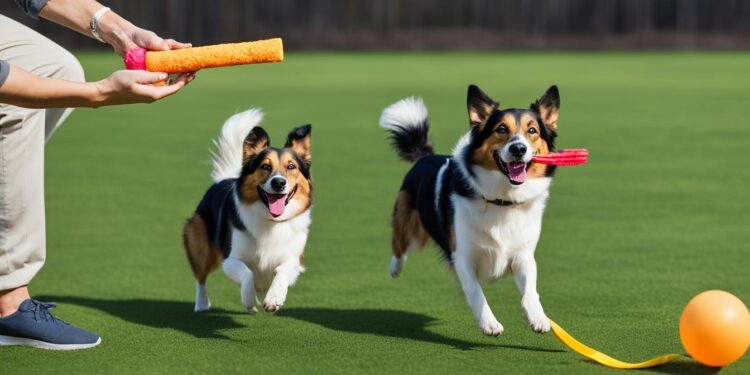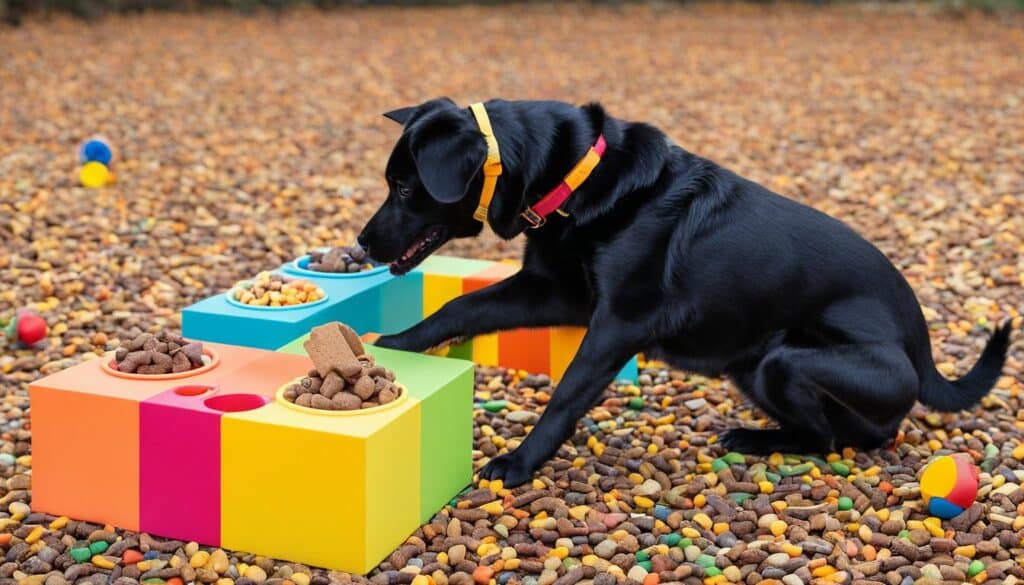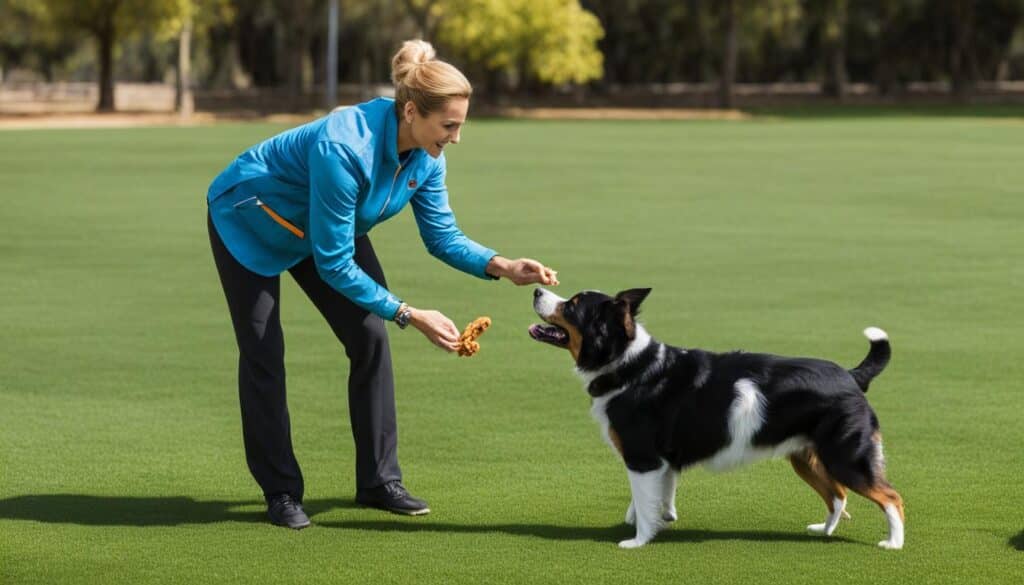Maximizing Positive Reinforcement in Dog Training

Positive reinforcement training is a proven and effective method for teaching dogs new behaviors. By utilizing rewards and positive reinforcement, such as treats or praise, dogs are more likely to repeat the desired behavior in the future. This approach to training is based on understanding and addressing the fundamental principles of dog behavior.
When implementing positive reinforcement training, it is crucial to consider the rewards from the dog’s perspective. Dogs have individual preferences and motivations, so it’s essential to select the most rewarding options for your furry companion. By understanding your dog’s preferences and ranking rewards based on their value, you can maximize their motivation and training success.
The timing and placement of rewards also play a pivotal role in effective training. By delivering rewards promptly and precisely, you clarify to your dog which behaviors are being reinforced. Using markers, such as clickers or whistles, can enhance communication and accelerate the learning process.
To further emphasize the importance of positive reinforcement in dog training, scientific evidence supports its efficacy and emphasizes its humane nature. Reward-based training methods prioritize building a strong bond between dogs and their handlers while fostering a positive and safe training environment.
Let’s explore how to choose the right rewards for your dog, ensuring optimal training results while maximizing their well-being and enjoyment.
Choosing the Right Rewards for Your Dog
When it comes to training your dog, selecting the right rewards is crucial for success. Choosing rewards that truly motivate and excite your furry friend encourages them to consistently repeat desired behaviors. But how can you determine which rewards will be most effective for your dog?
First, it’s essential to understand that different dogs have unique preferences. Just as humans have their favorite treats or activities, dogs also have their own likes and dislikes. To identify the most rewarding options for your dog, make a list of things they enjoy—this can include treats, praise, toys, or opportunities to engage in their favorite activities.
Once you’ve made a list, rank these rewards based on their level of excitement for your dog. Consider which rewards elicit the most enthusiasm and which are less enticing. By creating a reward hierarchy, you’ll have a clear understanding of what motivates your dog the most.
Now that you have a reward hierarchy in place, it’s important to consider the difficulty of the training task at hand. Use higher-ranked rewards for more challenging behaviors, as they are likely to provide stronger motivation. This strategic approach helps keep your dog engaged and motivated throughout the training process.
Remember: the reward choice should align with the difficulty of the task.
Examples of Reward Hierarchy:
| Reward | Rank (High to Low) |
|---|---|
| Tasty treat | 1 |
| Belly rub | 2 |
| Interactive toy | 3 |
| Playtime at the park | 4 |
By taking into account your dog’s reward hierarchy and tailoring your training approach accordingly, you can maximize their motivation and increase the likelihood of successful training outcomes.
In the next section, we will explore the impact of rewards and the rate of reinforcement in training, along with techniques for timing the distribution of rewards. Understanding these factors will further enhance your dog training skills.
Rewards and Rate of Reinforcement
In the process of dog training, there are often competing rewards from the environment that can distract your furry friend. To ensure successful training, it’s crucial to make sure that the rewards you offer are more enticing than any distractions that may be present. This can be achieved by increasing the rate of reinforcement, which refers to how often you provide rewards to your dog.
When dealing with training distractions, such as a busy park or other dogs, it’s important to keep your dog engaged and focused on the desired behavior. Offering a reward for every step can be an effective strategy when teaching your furry friend to “heel” in a distracting environment. By doing so, you reinforce the desired behavior and help your dog understand what is expected of them.
“Using a high rate of reinforcement is key to maintaining your dog’s focus and motivation during training sessions.”
Increase the rate of reinforcement by providing rewards immediately after your dog performs the desired behavior. This helps strengthen the association between the behavior and the reward. By doing so consistently, your dog will quickly learn and respond to your commands.
Remember that rewards should be highly valuable to your dog. It is important to consider their preferences and rank the rewards based on their value to your furry friend. By offering rewards that are more enticing than the distractions present, you can effectively capture and maintain your dog’s attention during training.
Finally, keep in mind that every dog is unique, and what works for one may not work for another. Pay close attention to your dog’s reactions and adjust the rate of reinforcement accordingly. The goal is to create an engaging and rewarding training experience that sets your dog up for success.

Competing Rewards in Training
During training sessions, it’s common for dogs to encounter competing rewards from the environment. These rewards can vary from interesting scents to other animals or even the opportunity to explore. To ensure successful training, your rewards should be more captivating than these distractions.
By understanding your dog’s preferences and providing rewards that are more enticing, you can overcome the impact of competing rewards. For example, if your dog is highly food motivated, using high-value treats during training can help keep their attention focused on you rather than the distractions around them.
It’s also important to consider the intensity of the distractions your dog may encounter. In highly stimulating environments, such as crowded parks or busy streets, it may be necessary to increase the rate of reinforcement to maintain your dog’s engagement. Offering rewards more frequently will help keep your dog’s attention and reinforce the desired behaviors.
| Benefits of Increasing the Rate of Reinforcement | Considerations |
|---|---|
| 1. Keeps your dog motivated and engaged. | 1. Be consistent in your reward delivery. |
| 2. Reinforces the desired behaviors more effectively. | 2. Use high-value rewards to compete with distractions. |
| 3. Helps your dog understand what behavior is being rewarded. | 3. Adjust the rate of reinforcement to the training environment. |
Timing the Distribution of Rewards
The timing of reward delivery plays a critical role in training dogs effectively. When rewards are not delivered promptly, dogs can become confused about which behavior they are being rewarded for, diminishing the training outcomes. To ensure clarity and enhance learning, marker training is a recommended strategy. This involves the use of a marker, such as a clicker or whistle, to signal the precise moment when the desired behavior is exhibited by the dog.
Marker training, also known as clicker training, employs a distinct sound or visual signal to indicate that the dog has performed the desired behavior correctly. This technique enables precise timing in reward delivery, reinforcing the correct actions and facilitating faster learning.
Marker training provides dogs with immediate feedback, highlighting the exact behavior they are being rewarded for. By associating the marker with positive reinforcement, dogs learn to repeat the desired behavior more consistently.
When utilizing marker training, it is essential to establish a clear connection between the marker and the delivery of the reward. Initially, the marker is paired with a primary reinforcer, such as a treat or a toy, in a process known as “charging the marker.” This helps dogs understand that the sound or visual signal indicates the imminent provision of a reward.
The use of precise reward timing through marker training enhances the dog’s understanding of the desired behavior and promotes training precision. This approach allows for more effective communication between the trainer and the dog, facilitating the development of desired skills and behaviors.
| Benefits of Reward Timing: | Examples: |
|---|---|
| Enhanced clarity in communicating desired behaviors |
|
| Faster learning and reinforcement of correct actions |
|
| Increased preciseness in training |
|
By incorporating marker training techniques and maintaining precision in reward timing, dog trainers can optimize the learning process and achieve more accurate and reliable training results.

Placement of Rewards
In dog training, the placement of rewards plays a crucial role in reinforcing the correct behaviors and avoiding confusion. When teaching stationary positions like “sit,” it’s important to deliver the reward while the dog is in the desired position. By doing so, the dog associates the reward directly with the correct behavior, increasing the likelihood of repetition.
However, if the dog has to move or change position to receive the reward, it can lead to confusion. They may associate the reward with the incorrect behavior, which can hinder the training progress. To ensure clarity and prevent confusion, it’s essential to deliver the reward at the exact moment the dog is in the desired position.
For distance training, where the dog needs to remain in a specific location while following commands, finding ways to reward them while they are still in the desired position is crucial. This can be challenging when the handler is far away from the dog, but remote reward delivery devices can be utilized to address this challenge effectively.
“Reward placement is key to reinforcing the correct behaviors and avoiding confusion in dog training.”
Reward Placement Tips:
- Place the reward directly within the dog’s reach when training stationary positions.
- Avoid requiring the dog to move or change positions to receive the reward.
- Find ways to reward the dog while they are still in the desired location during distance training.
- Utilize remote reward delivery devices to reinforce desired behavior when the handler is far away from the dog.
By following these reward placement tips, trainers can effectively reinforce the desired behaviors and minimize confusion, leading to more successful and efficient training sessions.
| Benefit | Explanation |
|---|---|
| Clear Reinforcement | Delivering rewards in the desired position reinforces correct behaviors and reduces confusion. |
| Improved Training Efficiency | By avoiding unnecessary movements, trainers can save time and focus on reinforcing the desired behaviors. |
| Enhanced Performance | Proper reward placement enhances a dog’s understanding of desired positions and behaviors, leading to improved performance. |
Efficacy and Efficiency of Training Methods
When it comes to dog training, there are various methods available, ranging from aversive stimuli to reward-based techniques. Aversive methods have been controversial in recent years due to their potential negative impact on dog welfare. On the other hand, reward-based methods have gained popularity for being more humane and effective in shaping desired behaviors. However, the scientific literature on the efficacy and efficiency of these different training methods remains limited and inconsistent.
Further research is crucial in order to evaluate the effectiveness of reward-based training compared to aversive methods. Understanding the strengths and weaknesses of each approach will provide trainers and dog owners with valuable insights for making informed decisions about their training practices. It will also contribute to the ongoing development of evidence-based guidelines that prioritize dog welfare and promote positive training experiences.
“The welfare of the animal must be considered in all training programs. Training should be completed with the least possible amount of aversive stimuli and instead focus on the use of rewards to reinforce desired behavior.” – American Veterinary Society of Animal Behavior (AVSAB)
The AVSAB emphasizes the importance of considering dog welfare in training programs, urging trainers to minimize the use of aversive stimuli and prioritize the use of rewards. This aligns with the growing consensus among experts and professionals that reward-based methods are not only more effective but also more ethical and conducive to the overall well-being of dogs.
Evaluating Method Effectiveness and Efficiency
Effectiveness refers to the ability of a training method to achieve the desired outcomes and modify the dog’s behavior effectively. Efficiency, on the other hand, focuses on the amount of time and effort required to achieve those outcomes.
While reward-based methods have shown promising results in terms of effectiveness, their efficiency can vary depending on factors such as the trainer’s skills, the dog’s individual characteristics, and the complexity of the behaviors being taught. Aversive methods, despite their potential drawbacks, may yield quicker results in some cases.
To comprehensively evaluate the effectiveness and efficiency of these training methods, a variety of factors need to be considered, including the dog’s breed, temperament, and specific training goals. It is also important to assess the long-term impact on the dog’s behavior, as well as their overall well-being and emotional state during the training process.
Striving for a Balanced Approach
While research on the efficacy and efficiency of training methods is ongoing, it is clear that reward-based methods offer significant advantages in terms of dog welfare and long-term behavior change. In order to optimize training outcomes, a balanced approach that combines rewards and positive reinforcement with appropriate aversive stimuli, if necessary, may be the most effective and ethical strategy.
| Training Method | Advantages | Disadvantages |
|---|---|---|
| Reward-Based Methods |
|
|
| Aversive Methods |
|
|
Training Philosophy and Welfare
Guide Dogs for the Blind is committed to ensuring the well-being of dogs through their training philosophy, which prioritizes positive reinforcement and minimizes the use of punishment. This approach, known as the Least Intrusive Minimally Aversive (LIMA) philosophy, recognizes the importance of building a strong bond between dogs and their handlers while promoting their welfare.
Within the LIMA philosophy, positive reinforcement takes center stage. Instead of focusing on correcting unwanted behaviors, the emphasis is on teaching dogs what to do. By rewarding desired actions with treats, praise, or play, dogs are motivated to repeat these behaviors, leading to effective training outcomes.
“The LIMA philosophy prioritizes positive reinforcement and focuses on teaching dogs what to do rather than punishing unwanted behaviors.”
This training philosophy is rooted in the belief that dog welfare should always be at the forefront. By using positive reinforcement techniques, dogs are not subjected to aversive stimuli, which can negatively impact their well-being and trust. Instead, dogs are empowered, given the opportunity to learn and make choices in a safe and supportive environment.
This approach also promotes the development of a strong bond between dogs and their handlers. By establishing a foundation built on trust, mutual respect, and clear communication, the training experience becomes enjoyable for both parties, fostering a positive and lasting relationship.
The commitment to dog welfare extends beyond the training process. Guide Dogs for the Blind ensures that each dog receives proper medical care, ample exercise, and socialization opportunities. This holistic approach to dog care further enhances their well-being and contributes to their overall happiness and success as guide dogs.
By embracing a training philosophy that centers on positive reinforcement and dog welfare, Guide Dogs for the Blind sets a high standard for training organizations worldwide. Through their commitment to the LIMA philosophy, they advocate for the use of effective and ethical training methods, ultimately improving the lives of both dogs and their handlers.
Conclusion
Positive reinforcement training is an effective and humane approach to teaching dogs new behaviors and strengthening the dog-human bond. By utilizing rewards that are truly rewarding to the individual dog and considering the timing and placement of those rewards, trainers can maximize the effectiveness of their training sessions.
Through positive reinforcement, dogs learn to associate desired behaviors with pleasurable outcomes, motivating them to repeat those behaviors in the future. This method not only leads to more reliable and consistent obedience but also creates a positive and enjoyable training experience for both dogs and their handlers.
Continued research and understanding of training methods and their impact on dog welfare are crucial for refining and improving positive reinforcement training techniques. By prioritizing positive reinforcement over punishment and implementing evidence-based training methods, trainers can ensure the well-being of their canine companions while achieving training goals.
In conclusion, positive reinforcement training offers numerous benefits, including effective learning, a strong dog-human bond, and ethical training practices. By embracing this approach and staying informed about the latest advancements in dog training, both trainers and dogs can thrive in their journey towards a harmonious and rewarding partnership.
FAQ
What is positive reinforcement training?
Positive reinforcement training is a method of teaching dogs new behaviors by providing rewards for desired actions, such as treats or praise.
Why is it important to choose the right rewards for my dog?
It is important to select rewards that are truly rewarding for your dog to maximize their motivation and training success.
How can I ensure that the rewards I offer are more enticing than distractions in the training environment?
To ensure that your rewards are more enticing, you may need to increase the rate of reinforcement and keep your dog engaged and focused.
Why is timing important in reward delivery?
Timing of reward delivery is crucial to ensure that your dog understands which behavior they are being rewarded for.
How should I place rewards during training?
Rewards should be given while the dog is in the desired position or location to avoid confusion and reinforce the correct behaviors.
Are reward-based training methods more effective than aversive methods?
While reward-based methods are considered more humane and effective, further research is needed to evaluate their effectiveness compared to aversive methods.
What is the training philosophy followed by Guide Dogs for the Blind?
Guide Dogs for the Blind follows the LIMA philosophy, which prioritizes positive reinforcement and minimizes the use of punishment to promote dog welfare and build a strong bond between dogs and their handlers.
How can positive reinforcement training benefit the relationship between dogs and humans?
Positive reinforcement training is a valuable tool for teaching dogs new behaviors and fostering a positive relationship between dogs and their handlers.






